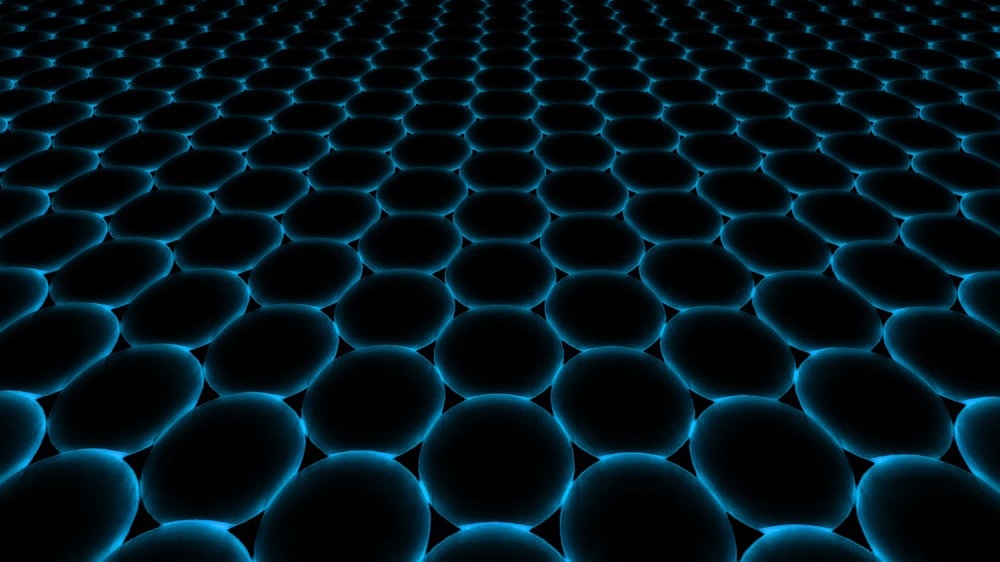Sonography is a diagnostic imaging technique that uses high-frequency ultrasound waves to create images of internal body structures. Despite its low cost, non-invasiveness, and high penetration ability, the application of sonography is limited because of the lack of high-precision imaging.

Study: Dual-Mode Fluorescence/Ultrasound Imaging with Biocompatible Metal-Doped Graphene Quantum Dots. Image Credit: GiroScience/Shutterstock.com
In this respect, ultrasound contrast agents (UCAs) enhance the density of ultrasound waves in target tissues by complementing near-infrared (NIR) and visible fluorophores. An article published in the journal ACS Biomaterials Science and Engineering presented a variety of metal-doped (silver nanoparticles (Ag NPs), neodymium (Nd), thulium (Tm), cerium chloride (CeCl3), cerium oxide (CeO2), and molybdenum sulfide (MoS2)) nitrogen-containing graphene quantum dots that exhibited high-contrast properties in the ultrasound brightness mode and imaging capabilities with visible and NIR fluorescence.
Graphene quantum dots were prepared from glucosamine and a minimal metal was doped to avoid additional in vitro toxicity. While the small size of the graphene quantum dots promoted effective cell internalization, the polar nature of the surface functional groups increased their water solubility and facilitated the attachment of targeting agents and therapeutics.
The metal-doped nitrogen-containing graphene quantum dots exhibited a 10-fold enhanced ultrasound signal in animal tissues, agarose gel, and vascular phantoms. The combined effect of high-precision fluorescence tracking and noninvasive ultrasound imaging makes graphene quantum dots a feasible agent for a wide range of theragnostic applications.
Role of Contrast Agents (CAs) in Sonography
Sonography uses a device called a transducer on the skin's surface, which sends and receives ultrasound waves to and from tissues. A computer translates the received ultrasound waves into an image that is then read to diagnose the problem.
Medical ultrasound differentiates internal organs from the surrounding tissues based on their different acoustic impedances. However, when this differentiation is difficult to track, contrast-enhanced ultrasound (CEUS), an established technique for visualizing liver lesions, cardiac imaging, and renal carcinoma, is used for more specific detections. Although microbubbles in UCAs make them biocompatible, they have a short circulation as they dissociate in the bloodstream or are engulfed by Kupffer cells.
Graphene quantum dots exhibit excellent solubility in organic solvents. However, their improved solubility in water-based solvents has profoundly influenced their application in bioimaging and targeted drug delivery systems.
The water solubility can be attributed to the hydroxyl- and carboxyl-containing moieties attached to the surface of the graphene quantum dots. Surface functionalities enhance the hydrophilic nature of graphene quantum dots so that surface functionalization can be tuned through chemical modifications.
Biocompatible Metal-Doped Graphene Quantum Dots
Previously, highly biodegradable and biocompatible nitrogen-containing graphene quantum dots were developed to serve as the basis for designing CAs and exhibited fluorescence in the NIR and visible regions.
The oxygen-containing functional groups on the surface of the graphene quantum dots underwent pH-dependent protonation/deprotonation in a biological environment, leading to the fluorescence of the quantum dots. In addition, the prepared graphene quantum dots have also shown sensitivity toward mitochondrial RNA (miRNA) and single-stranded DNA (ssDNA) detection, which is utilized for cancer diagnosis.
The present study aimed to test the fluorescence imaging and ultrasound contrast properties of various metal-doped (Ag NPs, Nd, Tm, CeCl3, CeO2, and MoS2) nitrogen-containing graphene quantum dots in tissues and cells to explore their multifunctionality and evaluate their advantages over existing agents. Here, various metal-doped graphene quantum dots were assessed for ultrasound imaging and dual-mode fluorescence capabilities in vitro and in tissue phantoms.
The results revealed that the developed graphene quantum dots yielded over 80% cell viability up to two milligrams per milliliter dose. The small sizes of these graphene quantum dots warranted effective cell internalization and the polar surface functional groups increased water solubility.
Furthermore, metal-doped nitrogen-containing graphene quantum dots showed maximum accumulation within HEK-293 cells after 6−12 hours of treatment. Additionally, the prepared graphene quantum dots showed a 10-fold enhancement in the ultrasound signal at a concentration of 0.5−1.6 milligram milliliter in agarose gel, animal tissue, and vascular phantom.
Thus, the development and application of multimodal fluorescence imaging and UCAs can concurrently improve the identification of cells and tissues, enable the tracking of therapeutic administration, and facilitate early diagnosis in a realistic setting.
Conclusion
In summary, the present work suggests that increasing the density of ultrasound scattering is not the only mechanism for imaging and that metal dopants play a crucial role in ultrasound contrast. Lightly metal-doped nitrogen-containing graphene quantum dots are promising visible and NIR fluorescence imaging agents and UCAs.
Graphene quantum dots have two complementary imaging modalities with a high penetration depth, specificity, and precision, making nitrogen-containing graphene quantum dots a powerful theragnostic platform for sensing, drug delivery, and imaging.
Reference
Valimukhametova, A et al. (2022). Dual-Mode Fluorescence/Ultrasound Imaging with Biocompatible Metal-Doped Graphene Quantum Dots. ACS Biomaterials Science and Engineering. https://pubs.acs.org/doi/abs/10.1021/acsbiomaterials.2c00794
Disclaimer: The views expressed here are those of the author expressed in their private capacity and do not necessarily represent the views of AZoM.com Limited T/A AZoNetwork the owner and operator of this website. This disclaimer forms part of the Terms and conditions of use of this website.